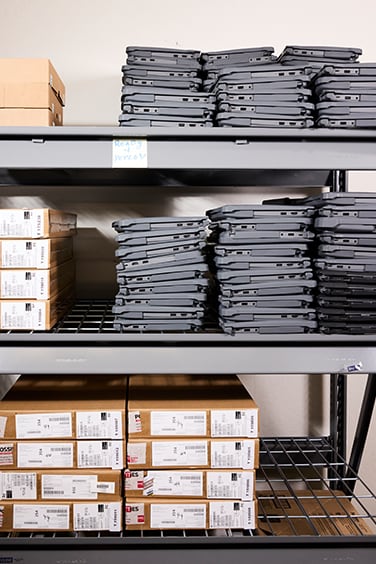April 03, 2024
How Investing in Technology Support Services Can Power K–12 Transformation
Mt. Diablo Unified School District’s close partnership with CDW drove daring technology modernization efforts in record time.
Several years ago, IT leaders at Mt. Diablo Unified School District knew that to create a 21st century learning environment, they would need to revamp everything from student devices and classroom audiovisual displays to network and data center infrastructure.
It was a big job, and even with a healthy team of 41 IT staffers, they knew they couldn’t do it alone.
“We’re supporting teachers and kids and business processes,” says Robert Sidford, director of technology and innovation for the 29,000-student district. “We don’t want to be out there making a bunch of mistakes. We need to support our core mission, and so we need to know what works, what we can afford and what is sustainable.”
As Mt. Diablo has embraced several digital transformation initiatives, leaders have come to rely on CDW — not only for hardware and software solutions but also for trusted third-party advice and value-added services. “CDW streamlines our processes,” Sidford says. “It provides us with a ton of advice and offers us expertise that we don’t always have in-house.”
And considering the breadth and scale of the critical technology upgrades across the district in a few short years, Sidford admits, “we would not be able to make moves as quickly without this partnership.”
Jeff Mitchell, a CDW advanced technology account executive for K–12, says the partnership with Mt. Diablo extends beyond technology. “We’re connected to the business office, we’re connected to the purchasing department, and we’re connected to the curriculum and instructional professionals,” he says. “They trust us to not only bring the right resources and expertise to meet the needs of their projects, but also answer any questions they have to make sure they’re leaving no stone unturned on the path to digital transformation.”
The Move to Modern Classroom Technology

CDW’s services have played a critical role in helping Mt. Diablo accelerate device and classroom equipment rollouts.
Prior to the COVID-19 pandemic, the district did not have a one-to-one student device initiative. “In 2020, we were basically throwing Chromebooks at people — pulling them out of carts, grabbing them from classrooms, finding extras,” recalls Sidford. “The devices were all different models and ages, but we were asking, ‘How can we get these to kids?’”
Since then (with some help from federal pandemic relief funds), the district has adopted a formal, standardized one-to-one Chromebook program that relies on CDW’s Chromebook deployment services to simplify deployment by configuring devices and enrolling them in management systems before delivering them to the district.
Until recently, individual school leaders across the district made IT purchasing decisions for audiovisual displays, resulting in a hodgepodge of products, with some schools boasting state-of-the-art equipment and others using outdated projectors.
Sidford wanted to move to a standardized, modern solution for all classrooms, which would reduce the burden on IT staff and give all students access to the same learning resources. “I see it as an equity initiative,” he says.
Working with district leadership and the board of education, Sidford decided to deploy Promethean interactive displays across the district. But he wanted to move quickly, and the district lacked the staff necessary to install 1,800 panels in a matter of months. CDW connected his team with a partner that handled the installation and configuration, allowing Mt. Diablo to completely transform its audiovisual environment in under a year. Additionally, through a deal arranged by CDW, Promethean provided the district with ongoing professional development for teachers to ensure that the technology makes a significant impact on classroom instruction.
“The district has two full-time Promethean trainers onsite for the first year of this project,” Mitchell says. “That is helping Mt. Diablo’s very small ed tech team with training, implementation and knowledge transfer, and making sure that the technology is effectively adopted in the classroom.”
36%
The percentage of K–12 technology leaders who said they were concerned about sustaining their current staffing levels
Source: CoSN, CoSN 2023 State of EdTech Leadership: Tenth Annual National Survey, April 2023
The State of Ed Tech Investment
In its 2023 annual survey of K–12 technology leaders, the Consortium for School Networking discovered the following:
63%
of K–12 school districts (nearly two-thirds) spend less than 5 percent of their total budget on technology, while 20 percent (or 1 in 5 districts) spend less than 2 percent.
85%
of districts have partially or fully implemented single sign-on, making that the top interoperability initiative.
60%
of districts require free tech tools to be reviewed by their IT departments before they can be used in classrooms, while 20 percent of districts do not have any process for reviewing or approving free tools.
80%
of K–12 school districts have connection speeds of 1 gigabit per second or faster between their WAN and LAN switches, and 21 percent have a 10Gbps or faster connection.
60%
of ed tech leaders say they are concerned about their district’s ability to sustain student access to devices as one-time COVID-era funding sources run dry; 40 percent say they’re concerned about their ability to renew software licenses.
Simplifying and Securing Mt. Diablo’s Back-End Infrastructure
Before Mt. Diablo’s partnership with CDW, the district was hamstrung by antiquated procurement practices that required bidding out any project over $5,000. Not only did this slow down projects but also — because of prices — sometimes prevented the district from working with larger vendors and service providers that might have been a better fit. This happened because the district looked primarily at numbers and didn’t factor in the additional value and expertise that partner services bring to the table.
“We were bidding out even really small cabling projects, and we ended up working with vendors that were not necessarily a good fit,” Sidford recalls. “When you have multiple vendors doing a variety of jobs, and you can’t ensure that the work is done to a standard, that creates problems. It meant that we ended up managing a bid process rather than managing IT projects and supporting students and educators.”
CDW connected Mt. Diablo with procurement collectives that allow the district to piggyback on projects whose vendors have already been vetted, saving the district time, resources and money. Since then, the district has extensively used Sourcewell, a cooperative purchasing agency for public sector organizations. This has helped Mt. Diablo accelerate the pace of IT investment in a way that keeps costs under control and complies with state regulations.
The new purchasing practices have helped Mt. Diablo dramatically overhaul its infrastructure in just a few years. The district has invested in new high-availability firewalls, hyperconverged infrastructure, a redundant Aruba 8400 high-availability core switch, modern security cameras and a new video management system. Additionally, the district implemented new backup capability, as well as managed detection and response.
The infrastructure improvements were needed, Sidford explains, to future proof the district and ensure that staff members are able to maintain and manage the IT environment over time. “We had a data center that had grown as the district’s needs grew, rather than being intentionally planned out,” he says. “We had a variety of systems that required more technical expertise than we had on staff. We’re never going to be able to compete for talent, from a salary perspective, with the biggest companies in the San Francisco Bay area. So, it was really important to simplify and streamline the data center, and CDW helped us with that.”

“We’re never going to be able to compete for talent, from a salary perspective, with the biggest companies in the San Francisco Bay area. So, it was really important to simplify and streamline the data center, and CDW helped us with that.”
— Robert Sidford, Director of Technology and Innovation, Mt. Diablo Unified School District
Key Ingredients for Successfully Managing Digital Transformation in K–12
Partner services in K–12 are important, Mitchell says, not because districts lack the skills to deploy and manage technology but because they lack the capacity. “Do schools have staff who can build mobile carts and roll out displays to classrooms? Sure,” he says. “But do they have a well-oiled machine to do that? Is that their business model? Do they have a warehouse ready to receive pallets stacked with hundreds of 300-pound digital displays? Usually not.”
Mitchell continues, “During the COVID pandemic, IT directors in K–12 assumed 10 new job roles without adding any employees to their staff. So, they have to do more with less, and that means they often need to work with partners if they want to be efficient.”
Sidford says there is “no one factor” that will lead to a successful digital transformation effort in K–12, but he notes that careful planning, buy-in from district leadership and effective communication are all critical. “If you involve people in the change, they actually love it,” he says. “For the most part, change will be accepted if we’re actively improving technologies and services, and if the district leadership spends time explaining why we’re doing what we’re doing.”
While some Mt. Diablo educators initially resisted the district’s centralized digital transformation effort, Sidford says, those people now propose new ways to standardize classroom technology. “I’ve got people coming up to me and saying, ‘Wouldn’t it be really great if we got on top of esports before the schools start asking for it?’ Or, ‘Wouldn’t it be great if we got on top of virtual reality?’ And I say, ‘Yes, that would be great. Let’s start looking at it.’”
MKT71638

